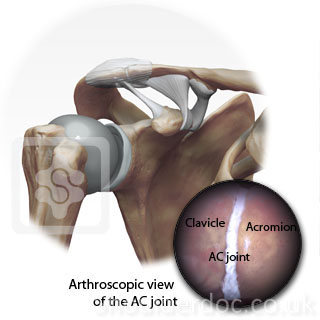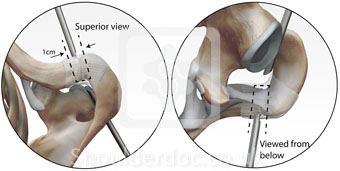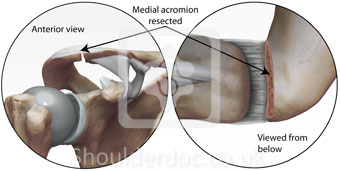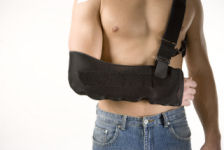ACJ Excision
Arthroscopic ACJ Excision
The operation aims to remove the painful and damaged Acromioclavicular Joint (ACJ) without destabilising it. This may be damaged from injury or arthritis. An Arthroscopic Subacromial Decompression (ASD) is often done as part of the procedure as Subacromial Impingement is often coexistent.

Below is the procedure:
- The shaver is inserted from the front of the AC Joint and the worn surfaces of the joint removed completely

- The CA ligament is resected from the underside of the acromion

- Bone is resected from the medial portion of the acromion, so that the whole lateral end of the clavicle is visible.

- The lateral end of the clavicle is removed, while preserving the superior capsule and ligament to preserve stability.

SURGICAL ANIMATION |
GENERAL GUIDELINES
PAIN
A nerve block is used during the operation which means that immediately after the operation the shoulder and arm may feel numb. This may last a few hours. After this the shoulder may well be sore and you will be given painkillers to help this whilst in hospital. These can be continued after you are discharged home. Ice packs may also help reduce pain. Wrap frozen peas or crushed ice in a damp, cold cloth and place on the shoulder for up to 15 minutes. In order to maintain a dry wound cover the dressing / wound with some cling film before applying the ice pack.
THE WOUND
This is a keyhole operation usually done through two or three 5mm puncture wounds. There will be no stitches only small sticking plaster strips over the wounds. These should be kept dry until healed. This usually takes 5 to 7 days.

WEARING A SLING
You will return from theatre wearing a sling or Cryocuff. This is for comfort only and should be discarded as soon as possible (usually within the first 2 to 4 days). Some people find it helpful to continue to wear the sling at night for a little longer if the shoulder feels tender.
SLEEPING
Sleeping can be uncomfortable if you try and lie on the operated arm. We recommend that you lie on your back or on the opposite side, as you prefer. Ordinary pillows can be used to give you comfort and support.
If you are lying on your side one pillow slightly folded under your neck gives enough support for most people.
A pillow folded in half supports the arm in front and a pillow tucked along your back helps to prevent you rolling onto the operated shoulder during the night.
If you are lying on your back, tie a pillow tightly ion the middle (a "butterfly pillow") or use a folded pillow to support your neck. place a folded pillow under the elbow of the operated arm to support that.


PAIN CONTROL
Some degree of discomfort is common after surgery. You should not have to 'put up' with pain. You will be given painkillers and anti-inflammatories from the hospital. The Cryocuff and nerve block also help any post-operative pain.
Click Here for more information
DRIVING
You may begin driving when you feel able to handle a steering wheel easily with both arms. You should be able to get your arm above shoulder level comfortably and manipulate objects at this level. For most patients this is usually about one week after surgery. If you are unsure, check with your therapist and/or surgeon.
RETURNING TO WORK
This will depend on your occupation. If you are in a sedentary job you may return as soon as you feel able usually after one week.
If your job involves heavy lifting or using your arm above shoulder height you may require a longer period of absence.
LEISURE ACTIVITIES
You should avoid sustained, repetitive overhead activities for three months. With regard to swimming you may begin breaststroke as soon as you are comfortable but you should wait three months before resuming front crawl. Golf can begin at six weeks. For guidance on DIY and racquet sports you should speak with your physiotherapist.
FOLLOW UP APPOINTMENT
A follow up appointment with the shoulder team will be made for three weeks after your operation. The amount of physiotherapy will depend on your individual needs.
PROGRESS
This is variable. However experience shows us that by 3 weeks movement below shoulder height becomes more comfortable. By this stage you should have almost full range of movement although there will probably be discomfort when moving the arm above the head and when lying directly on your shoulder.
At three months after your surgery your symptoms should be approximately 80% better and you will continue to improve for up to a year following the procedure.
POSTURE
Correct posture is one of the most important things to achieve following your surgery. It allows the shoulder to move in the way it was supposed to do without placing stresses and strains on the joint and muscles. See post-operative exercises for the correct posture position.
Click Here for the Post-operative Rehab Protocol


